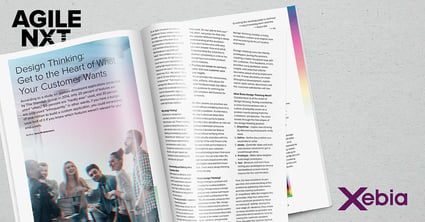According to a study on custom-developed applications conducted by The Standish Group in 2014, only 20 percent of features are used “often,” 50 percent are “hardly ever” used, and 30 percent are only used “infrequently.” In other words, if you have a budget of one million to build a custom application, you could immediately save half of it if you knew which features weren’t relevant for your end-users.
This article is published in  . Agile NXT is a new magazine full of inspiration for professionals on the emerging Agile journey. It challenges you to think differently and improve yourself, your team, and company a little more each day.
. Agile NXT is a new magazine full of inspiration for professionals on the emerging Agile journey. It challenges you to think differently and improve yourself, your team, and company a little more each day. 
As an Agile consultant and trainer, I wondered if these numbers were accurate - and what that might mean for companies in the midst of an Agile transition. I conducted a survey of 25 members of the NLScrum MeetUp group in July 2018 and asked, “How confident are you (on a scale from 1 low -10 high) that the Scrum team in your organization is creating high-impact solutions and features for the users?” The average answer was a 5.2. I also asked, “On a scale of 1-10, how strong is your urge to improve this?” Their responses averaged 8.3. Based on this survey, I think it’s fair to conclude that there’s room for improvement. Agile, or waterfall, if you are not making the right priority decisions, you will not create high impact solutions.
Why Design Thinking?
The American management consultant, educator, and author Peter Drucker said, “There is nothing so useless as doing efficiently that which should not be done at all.” Building and maintaining product features that are “hardly ever” used not only increases implementation
and maintenance costs, it also increases the overall time-to-market. Besides, who gets inspired and motivated to build something that will hardly ever get used?
Understanding and Defining What Customers Want
What makes it so difficult to understand and define what customers want? Creating features customer don’t want generates “invisible waste.” But it’s difficult to detect when companies are doing this for two main reasons:
- The wrong assumption - customers know what they want
During the design process, we talk to end users and often assume that they know what they want. However, the truth is, customers only know what they want in broad strokes. Steve Jobs said, “It’s not the customer's job to know what they want. It’s our job to find out.” Too often, we jump too fast into the solution without having a deep understanding of the problem. If you don't know who and why you can't answer how and what. Understanding the customer’s situation completely is critical for designing a successful product and its features. - Priorities are based on opinions rather than real customer data and insights
Scrum provides the ceremonies, roles, artifacts, and values for quick feedback loops but offers less guidance for defining the right solutions and features for customers. We often assume our priorities are correct without validating them first, and that's a problem. Furthermore, the way in which we determine priorities is also partly to blame. Too often, time /deadlines or internal political stakeholder pressures influence a decision (or feature choice) without verifying if that choice actually resonates with the customer. In the end, there’s only one way to find out if a feature is meaningful for your customer - constantly testing to learn from your end users. You can only make the right decisions based on the data and insights collected from those tests. That’s where design thinking comes into play.
What is Design Thinking?
Design thinking is a process and a mindset for creative problem-solving. Partially rooted in design practices and creative techniques taught at MIT and Stanford in the ‘50s, the innovation company Ideo popularized it in the ’90s. Design thinking enables cross-functional teams to work in a customer-centric way so that the products they make resonate in the market, are loved
by the customers, and generate business value. Implemented daily, the problem-solving potential of design thinking creates a living innovation culture and inspires new and surprising forms of creative teamwork.
Design thinking uses low-fidelity prototypes during the process, creating a faster feedback loop with the customer. This feedback, in turn, provides early guidance, better insight, and data that informs decisions about what to implement, or not. If wise decisions are made throughout development, maintenance costs will be decreased, and the customer satisfaction will rise.
How Does Design Thinking Work?
Collaboration is at the heart of design thinking. During a workshop, a cross-functional team with a culture of empathy works on a problem worth solving from the customers’ perspective. The team moves through the five stages of the design thinking process:
1. Empathize - Inspire new thinking by discovering what people really need.
2. Define - Define the problem you would like to solve.
3. Ideate - Generate ideas and push past obvious solutions to get to breakthrough ideas.
4. Prototype - Make ideas tangible - build rough prototypes.
5. Test - Measure and learn from testing your prototypes to receive fast feedback to learn how to improve for the next iteration.
First, the team broadens its perspective and understanding of the problem by gathering information and interviewing customers (1- empathize). With the insights this generates, they then determine which particular problem to focus on solving (2- define). During the next stage (3- ideation), they create as many solutions as possible and determine which would be best for solving the customer problem. They visualize this solution by building a prototype (4), and then test (5) it, face-to-face with the customer. From the feedback this generates, the team learns what resonates and what doesn't, and can adapt the solution to meet the customer’s needs in the next iteration.
Depending on the complexity of the challenge, a design thinking workshop can take between two and four days and is familiar in the context of a design sprint. As Jake Knapp of Google Ventures describes in his book, “Sprint,” a design sprint uses the design thinking framework with
a timebox of four days.
Many organizations and teams have successfully used design thinking and companies such as SAP, IBM and, ING have created their own innovation centers where design thinking is part of their daily way of working.
Maintaining a Continuous Feedback Loop
Conducting an initial design thinking workshop with your team is a great way to start this continuous feedback loop, and its the only way to reduce uncertainty. Some Scrum teams kick-off with a design sprint to gain a deeper understanding of the customer and quick improvement ideas, as described by Rezai Mohsen’s article, “Kick-Start Your Agile Team With Design Sprint” in this magazine. However, at the end of the day, you need to reduce or completely remove any uncertainty as to whether your customers will use your solution before you start building it.
After a first design thinking workshop, the team defines the riskiest assumptions as a next step, then tests those in small sprints, and validates at the end with the customer. For example, suppose a Scrum team is tasked with improving the overall digital online banking experience. They begin with a three-day design thinking workshop that generates three potential
improvement ideas and paper prototypes. The initial customer feedback is promising, but the team still isn't sure which of the three features is most desirable for the end user (riskiest assumption). So, as an experiment, they create a simple landing page that outlines the three potential new features. Clicking on any one of these three takes the customer to a page that details that particular feature. The customer can leave an e-mail address to receive further news and information.
Creating the landing page is defined as a product backlog item and the team refines and defines the necessary user stories and tasks to pull this into the sprint. One week after the implementation, the team and relevant stakeholders come together to analyze the customers’ clicking data. Based on the data, the team concludes that the third idea resonates most with the customer and focuses on building and improving it. They keep an up-to-date dashboard that’s visible to all stakeholders and explain their decisions and priorities based on the data. The leadership team congratulates them on saving the company unnecessary costs by scrapping the first two ideas. The team has used design thinking to increase customer satisfaction and build brand loyalty.
In today’s fast-changing digital world, you can't afford to waste time, money and resources building features no one will use. Instead, focus on creating more features your customers will love and gain the competitive advantage. Customer retention and brand loyalty will grow.
Implementing a continuous design thinking loop and mindset will take an initial investment of time and energy, but it’s nothing compared to the risk and cost of building something nobody wants. According to my survey, 88 percent of of NLScrum members agree, design thinking helps product owners and Scrum teams create better products.
Want to know more about Agility and Design Thinking? Download  and start your personal change tomorrow.
and start your personal change tomorrow.






